Weekend on an electric bike with a gas generator

At the end of 2016, I assembled my first electric bike. Then I used it only for trips to work, and a modest battery with a capacity of 0.5 kWh on elements with LiFePO4 chemistry was barely enough for a distance of about 20 kilometers in Moscow. But the inspiring feeling, “It rides!” By itself! And I assembled it myself! ”Took me seriously and for a long time: in two years I went from a front-wheel drive (bicycle without depreciation) through an all-wheel drive to a rear-wheel hard drive (a bicycle with a shock absorber fork in front and without shock absorption in the back), which already could with sufficient comfortably move me along dirt roads and forest paths. The battery capacity also grew - 0.5 kW * h, 1.5 kW * h, 3 kW * h. Improving the characteristics of range and comfort, I stopped using the electric bike only as a vehicle for traveling to work and began the tradition of weekly trips for pleasure, without an obvious end goal. The new conditions for the use of equipment posed the next tasks for its improvement - and in the spring of 2019 I was leaving on a very serious device based on a spatial frame with a 6 kWh power reserve in the battery compartment and a powerful motor wheel in a sprung rear pendulum fork. The range of travel increased to guaranteed 150 kilometers in any reasonable conditions. But what to do when this is not enough? To increase the battery is expensive and difficult, to recharge on the road is a loss of time and the risk of "drying out" due to the lack of guaranteed charging points. I had to turn my electric vehicle into a hybrid with a gas generator! Inspired by sith 's story about driving an electric car in Canada, I decided to write this article about a test ride on an electric hybrid electric bike.
Under the cut a lot of photos!
Gas generator selection
I began by studying the state of the local market for gas generators. Pretty quickly a model was found that was almost uncontested in terms of characteristics - a compact and lightweight inverter generator with a rated power of 0.7 kW, which is widely represented in stores under different brands. What results does this addition to the main power plant achieve? I reasoned as follows: at a maximum speed of 50 km / h and an average speed of 40 km / h during daylight hours, you can be in motion for no more than 10 hours for reasons of comfort and safety. It turns out that a moped can drive no more than 400 kilometers per day. With an average power consumption of 30 W * h / km, a margin of 12 kW * h is required. We have already taken 6 kW * h "out of the socket" before leaving, therefore the generator must add 6 kW * h for movement and 6 kW * h for a full battery charge the next day. Given the losses, we take the power of the charger at 0.6 kW. The generator must provide electricity to this charger at least 20 hours a day - 10 hours while driving and 10 hours in parking lots. Well, according to preliminary calculations, everything is going well and besides the need to "rattle" part of the time in the night parking there are no obvious minuses of such a design. The generator is ordered and paid, it's time to move on to practice.
Travel preparation
I brought the generator to the garage under my own power in order to immediately assess the effect of its overall dimensions on the handling of the electricopedist. Everything arrived without problems:

The generator is equipped with a four-stroke engine, the crankcase of which according to the operating instructions should be filled with oil:

In the reviews about the generator, some users complained that when filling the oil it is difficult to maintain the level accurately and at the first start the generator may “spit” with excess oil and stall. It happened with me. Using a syringe with a tube, excess oil was removed from the crankcase and the problem disappeared:

A test run with a load showed that the generator is working stably, the charger pours its promised 7.5A into the battery. It's time to put all the necessary equipment on a moped. The generator ideally hung on the right side of the trunk with the help of a lanyard, a canister with a fuel supply stood in the center of the trunk, on the left there was a bag for stocking supplies, tools and spare parts. Not heavy, but voluminous “foam” and a tent went to the steering wheel, while the charger, according to the residual principle, was pulled by a luggage gum right in front of the seat (not shown in the photo):


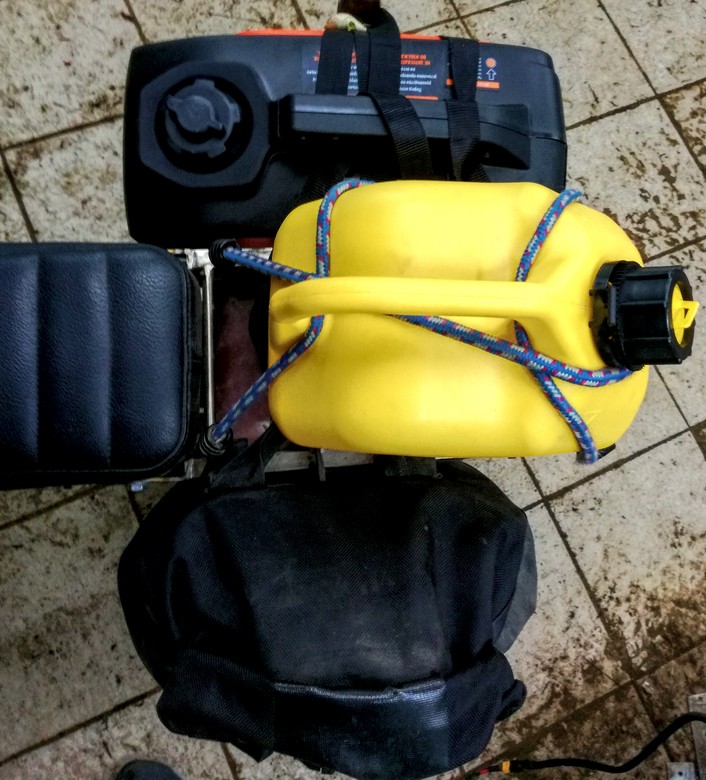
First day of the trip
Late Saturday morning I hit the road. Having traveled without incident the “boring” part of the path in the Moscow region, I went to the outskirts of Protvino:

A loaded moped steadily drove me both on asphalt and on sand:

Near Moscow forests ended, hilly fields of the Kaluga region began. On one of the fields I stopped for lunch:

He took off his equipment and backpack, put it on a moped. The number of things is impressive:

Near the Oka River, behind Tarusa, my generator stalled for the first time - affordable fuel was developed. The working time at one gas station was 4 hours 40 minutes - somewhat less than I expected. However, the reason was pretty obvious - the generator hanging on the trunk is not parallel to the horizon, which increases the undeveloped fuel residue in the tank. I filled the generator from the canister, started it again. The first minutes he worked unsteadily, deaf. I also encountered this effect after other refueling - apparently, the air in the fuel line. In the photo, the place of my first refueling and the majestic towers of the LEP-750 over the Oka (but this line is now used only under a voltage of 500 kV):
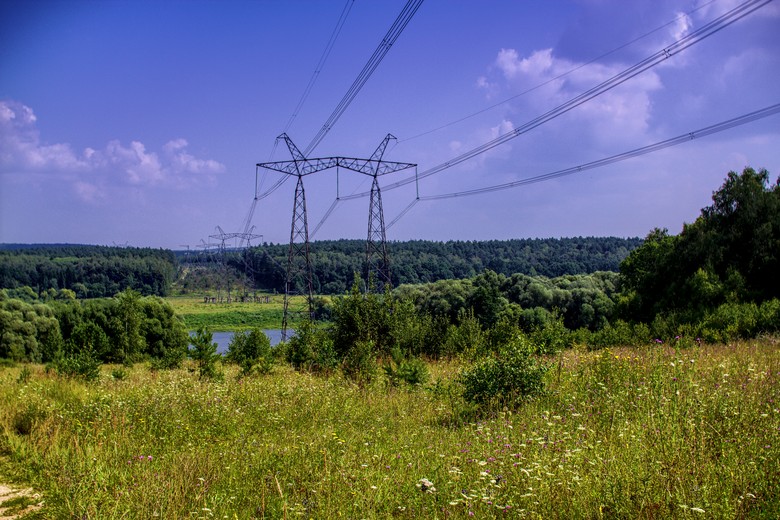
My further path ran along dirt roads through the villages of the Tarusa region. In the photo, the bogged primer:

The consequences of bathing in the “swamp” are purely cosmetic, the technique works properly:


Grader towards Alexin:

The border of the Kaluga and Tula regions:

A historical moment for me, the flow meter on the on-board computer screen shows the negative remaining energy in the battery:

Gradually evening came. Picturesque fields of the Yasnogorsky district:



I drive into the forest on the border of the Yasnogorsky and Venevsky regions. Hunting tower:
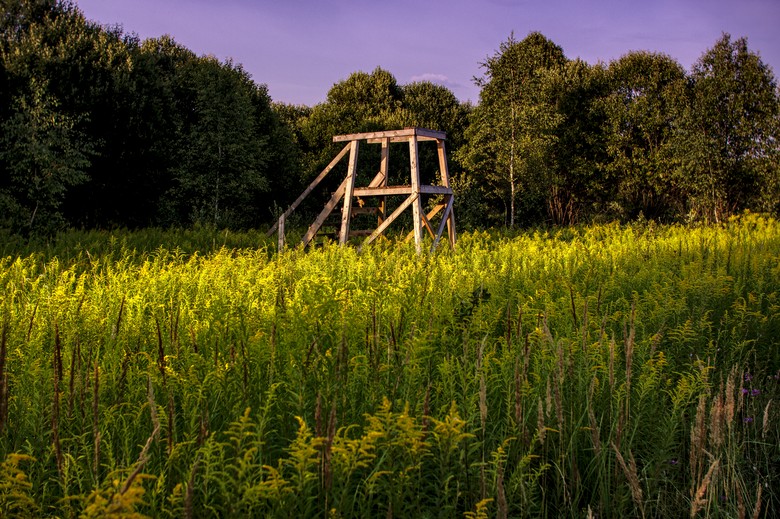
Exactly on the border of the areas of ford across the upper stream. This ford demanded from me my shoes and my motorcycle:

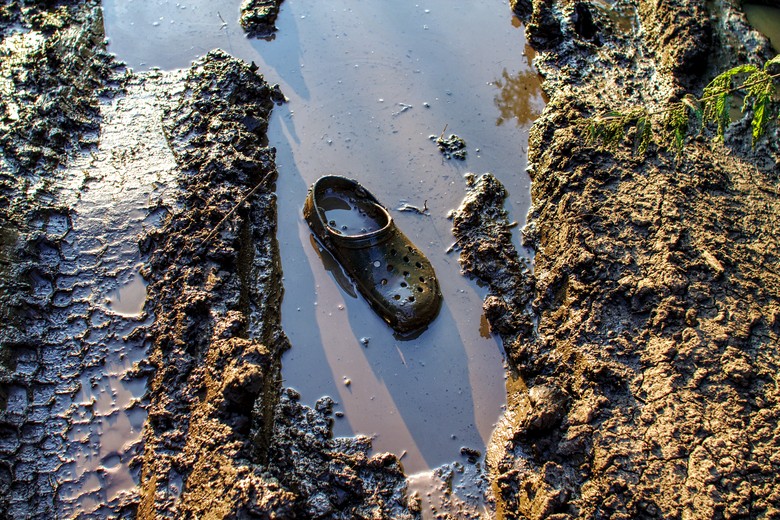

Exactly in the middle of the ford, while I was struggling with sticky and viscous dirt, the generator stalled again. Worked out 4 hours 50 minutes - not great, not terrible. Refueling again from the canister:
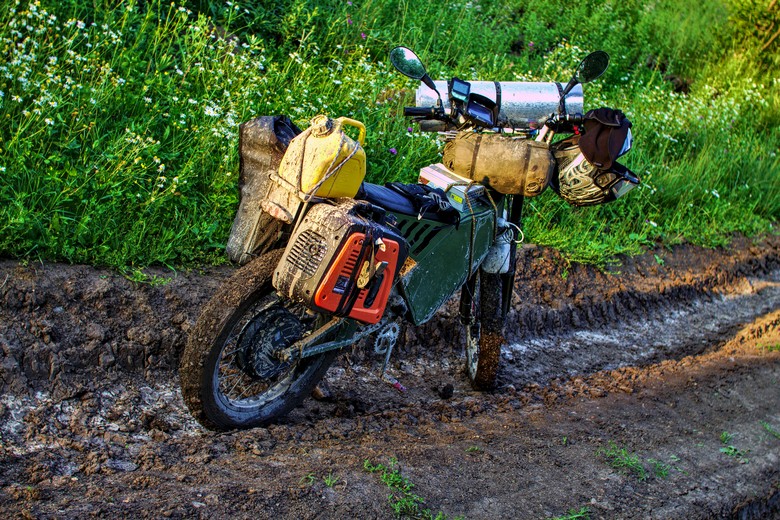
Sunset is near, it's time to get up for the night:

I put up a tent without an awning (warm and dry, dew is not expected, why the awning?):

I leave the generator to rumble until the fuel runs out and go to bed:

The result of the first day - 273.5 kilometers along the asphalt, grader and soil (sometimes difficult) in 11 hours, of which an hour was spent on refueling and snacking. At work, I am developing telematics controllers (car GPS trackers), and as a shoemaker with boots I ride a device of my own design on my moped. Here is a track drawn:


Second day of the trip
The generator on the remaining fuel was modified until about one in the morning and stalled. I did not refuel it - the daily mileage was small, there was enough energy. He spent the rest of the night in silence, poured the rest of the canister into the generator in the early morning, started it, had breakfast, and set off on his journey. The first thing I stopped at a gas station, scooped up a full canister of fuel there and added a little more directly to the generator tank. The morning was beautiful. Sturgeon Valley near the village of Metrostroevsky:

Abandoned buildings in a quarry. In quarries, stone was mined for the needs of the Moscow Metro, hence the name of the village:


Departure from the village of Metrostroevsky:

Early Sunday morning, no people, no cars around:

Only you, the fields around and the road going beyond the horizon:



The outskirts of the village of Shchuchye:

Surroundings of Pike fortification:

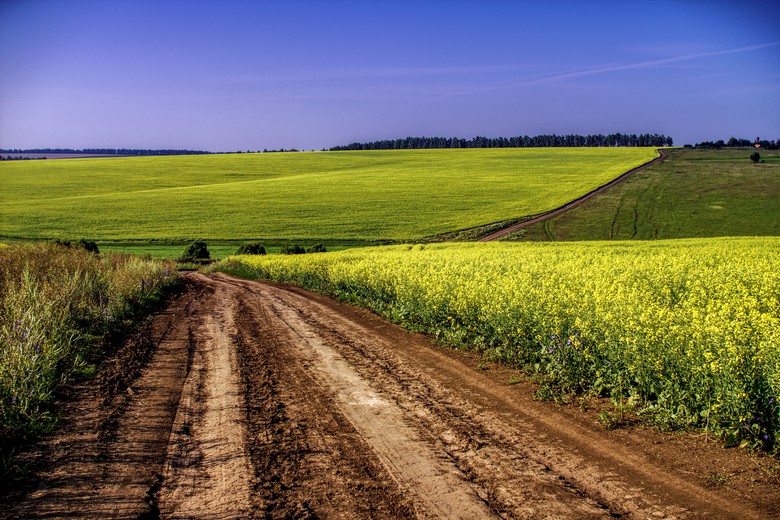

He stopped for lunch right in the hillfort:

Remains of the earthen rampart:

View from the hill fort on the rocky:

After lunch in the picturesque Pike fortification I turned to the house. Without waiting for the generator to stop, he added up to a full tank of fuel from the canister, after which he decided to go along the M6 and Old Kashirskoye Highway without any problems. The road through the fields to the highway M6:
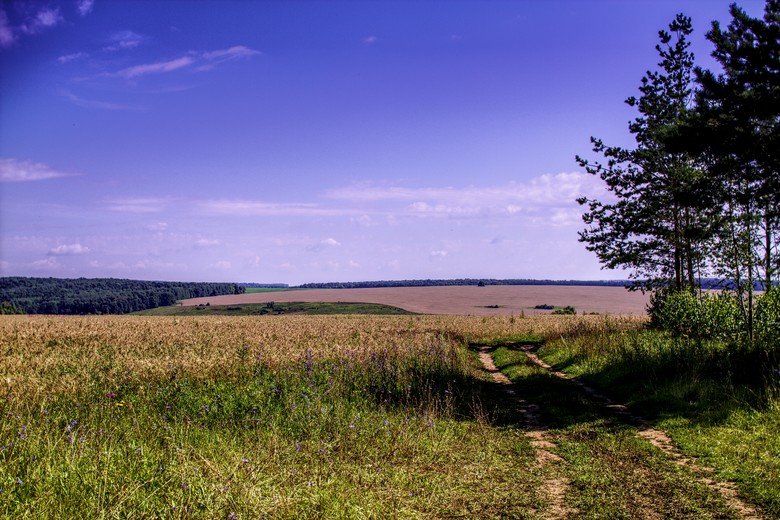
Most of the return journey went against the wind and “brought” home a flow rate of 33 W * h / km:

The result of the second day - 247.3 kilometers in 9 hours, of which 45 minutes were spent on snacks and refueling. Track:


findings
The circuit proved to be fully operational. If you do not set records in the form of mandatory 400 kilometers per day, and limit yourself to approximately 350 kilometers in advance, then you can travel by electric pedal for unlimited nothing but human endurance and the availability of fuel reserves distances. It was not possible to calculate the exact fuel consumption by the generator (for this I would have to pour all the gasoline from the tank and canister into a measuring tank, which I do not have),
but according to approximate calculations, the following goes:
I left with about 2 liters in the generator tank, poured about 2 more under Tarusa, poured about 2 more on the ford, refilled about 1 overnight, then added about 1 liter to the gas station and refilled about 1.5 liters before going onto the asphalt to home. This is approximately 9.5 liters, of which some (a liter and a half) remained in the tank upon arrival home. We get about 8 liters of gasoline consumed by the generator. I drove out on a fully charged battery - this is about 6 kW * h, and I "brought" home the rest of about 1.5 kW * h. From 17.5 kW * h spent on the on-board computer flowmeter, you need to subtract 4.5 kW * h and get about 13 "gas" kW * h in total. We get a gasoline consumption of about 0.6 liters per kWh or about 2 l / 100 km in the usual terms (with an electric power consumption of 33 W * h / km).
So, the pros: unlimited range, independence from infrastructure.
Cons: noise and vibration from the generator (relevant for owners of electric vehicles, accustomed to noiselessness), noise at the night parking (though tolerable - I slept under it), excess volume and mass of cargo (compared to a trip with refueling “from the outlet”) , non-environmental friendliness (relatively “clean” electric vehicles).
The first successful experience was obtained, ahead of the completion of the attachment points and luggage compartments and, I hope, there are still quite a few picturesque roads and adventures!
All Articles